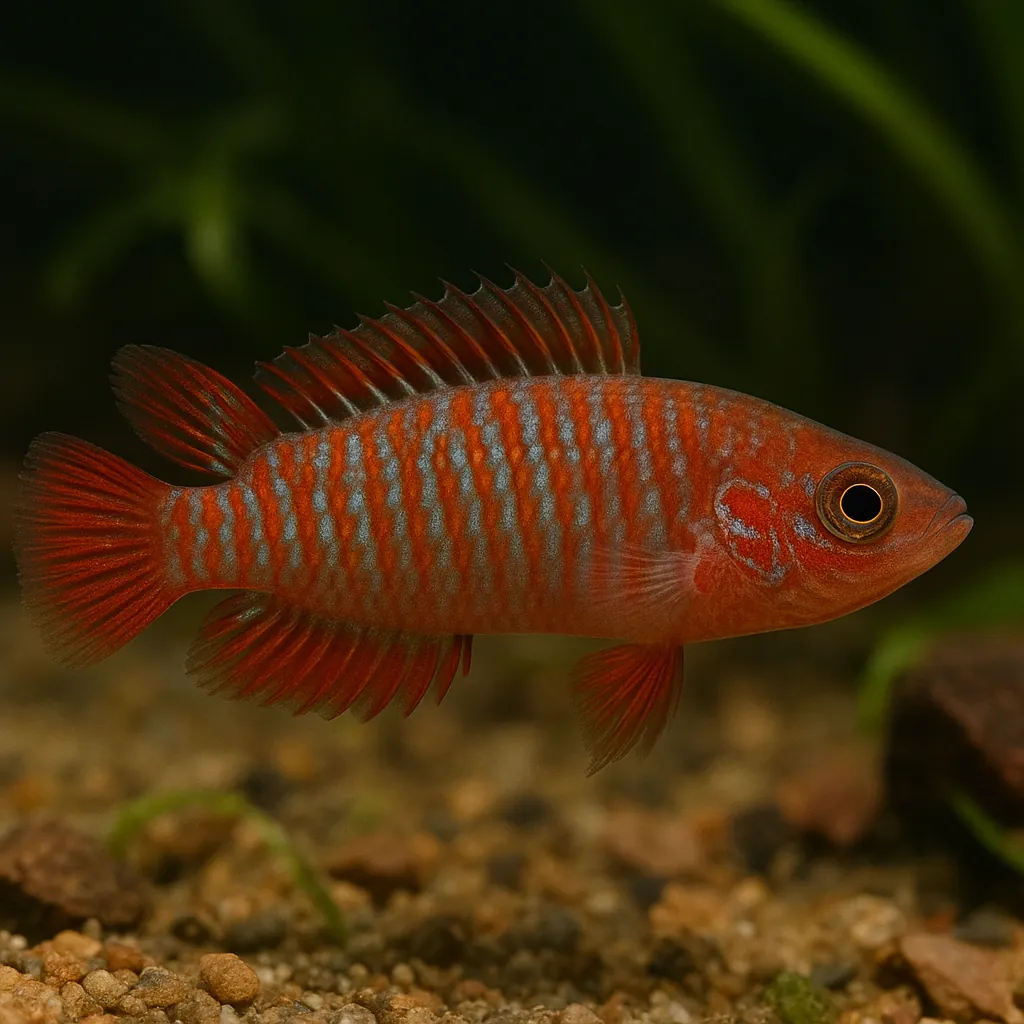
Scarlet badis
Introduction
The Scarlet Badis (Dario dario), also known as the Scarlet Gem Badis, is a captivating freshwater fish cherished by aquarists for its vibrant red and blue hues. Native to the slow-moving streams of India, this diminutive species adds a splash of color to nano and planted aquariums. While their striking appearance is a major draw, Scarlet Badis require specific care to thrive, making them more suitable for aquarists with some experience.
What makes the Scarlet Badis a popular choice among aquarists?
Their vivid coloration and small size make them ideal for nano tanks, and their unique behaviors provide endless fascination.
Are Scarlet Badis suitable for beginners?
Due to their specific dietary and environmental needs, they are better suited for aquarists with some experience.
Care and Environment
Providing optimal care for Scarlet Badis involves replicating their natural habitat and meeting their specific needs.
What is the minimum tank size for a Scarlet Badis?
A minimum of 10 liters is recommended for a single fish or pair, but larger tanks are preferable for groups.
What water parameters are ideal for Scarlet Badis?
Maintain temperatures between 22°C and 26°C, pH levels from 6.5 to 7.5, and water hardness between 3 to 12 dGH.
What type of filtration and lighting do they require?
Use gentle filtration to avoid strong currents, and provide moderate lighting to support plant growth and mimic their natural environment.
Scarlet Badis are micropredators, feeding on small live or frozen foods like daphnia, brine shrimp, and bloodworms. They may be reluctant to accept dry foods, so offering a varied diet is essential. A heavily planted tank with hiding spots, such as driftwood and caves, helps reduce stress and encourages natural behaviors. Be aware that males can be territorial, especially during breeding, so providing ample space and visual barriers is crucial.
Origin and Habitat
Scarlet Badis are native to the tributaries of the Brahmaputra River in West Bengal and Assam, India. They inhabit shallow, clear streams with sand or gravel substrates and dense aquatic vegetation. These environments offer ample hiding spots and a rich supply of small invertebrates, which constitute their natural diet. The water in these habitats is typically slow-moving, with temperatures ranging from 22°C to 26°C, and a pH between 6.5 and 7.5.
Where are Scarlet Badis found in the wild?
They are found in the Brahmaputra River tributaries in West Bengal and Assam, India.
What type of environment do they prefer?
They thrive in shallow, clear streams with sand or gravel substrates and dense vegetation.
Temperament and Compatibility
Scarlet Badis are generally peaceful but can exhibit territorial behavior, particularly among males. They are best kept in species-specific tanks or with small, non-aggressive fish that share similar water requirements.
Can multiple male Scarlet Badis be kept together?
It's advisable to keep only one male per tank unless the aquarium is large enough to establish separate territories.
What are suitable tank mates for Scarlet Badis?
Small, peaceful species like Ember Tetras, Pygmy Corydoras, and small Rasboras are suitable companions.
Are Scarlet Badis aggressive?
They are generally peaceful but can be territorial, especially males during breeding periods.
Interesting Facts
Scarlet Badis are among the smallest percoid fish species, with males reaching up to 2 cm and females slightly smaller. Males display vibrant red and blue colors, while females are more subdued. During breeding, males intensify their colors and perform elaborate courtship dances. They are micropredators, feeding on tiny invertebrates, and can be picky eaters in captivity. Their small size and unique behaviors make them a fascinating addition to nano aquariums.
How small are Scarlet Badis?
Males reach up to 2 cm, and females are slightly smaller.
What do Scarlet Badis eat?
They are micropredators, feeding on tiny invertebrates like daphnia and brine shrimp.
Do Scarlet Badis display unique behaviors?
Yes, males perform elaborate courtship dances and can be territorial during breeding.
Sources
All information in this article has been gathered from the following reputable sources:
Overview
Recommended Tank Size 5.3 Gallons (for groups of 6 or more) |
Minimum Group Size 1 |
Minimum Tank Volume 2.6 Gallons |
Maximum Adult Length 0.8 inches |
Average Adult Length 0.6 inches |
Shoaling (6+ required) No |
Preferred Water Type Freshwater, soft, slightly acidic to neutral |
Temperature Range (°C) 22–26 |
pH Range 6.5–7.5 |
Water Hardness (dGH) 3–12 |
Typical Lifespan (years) 3 years |